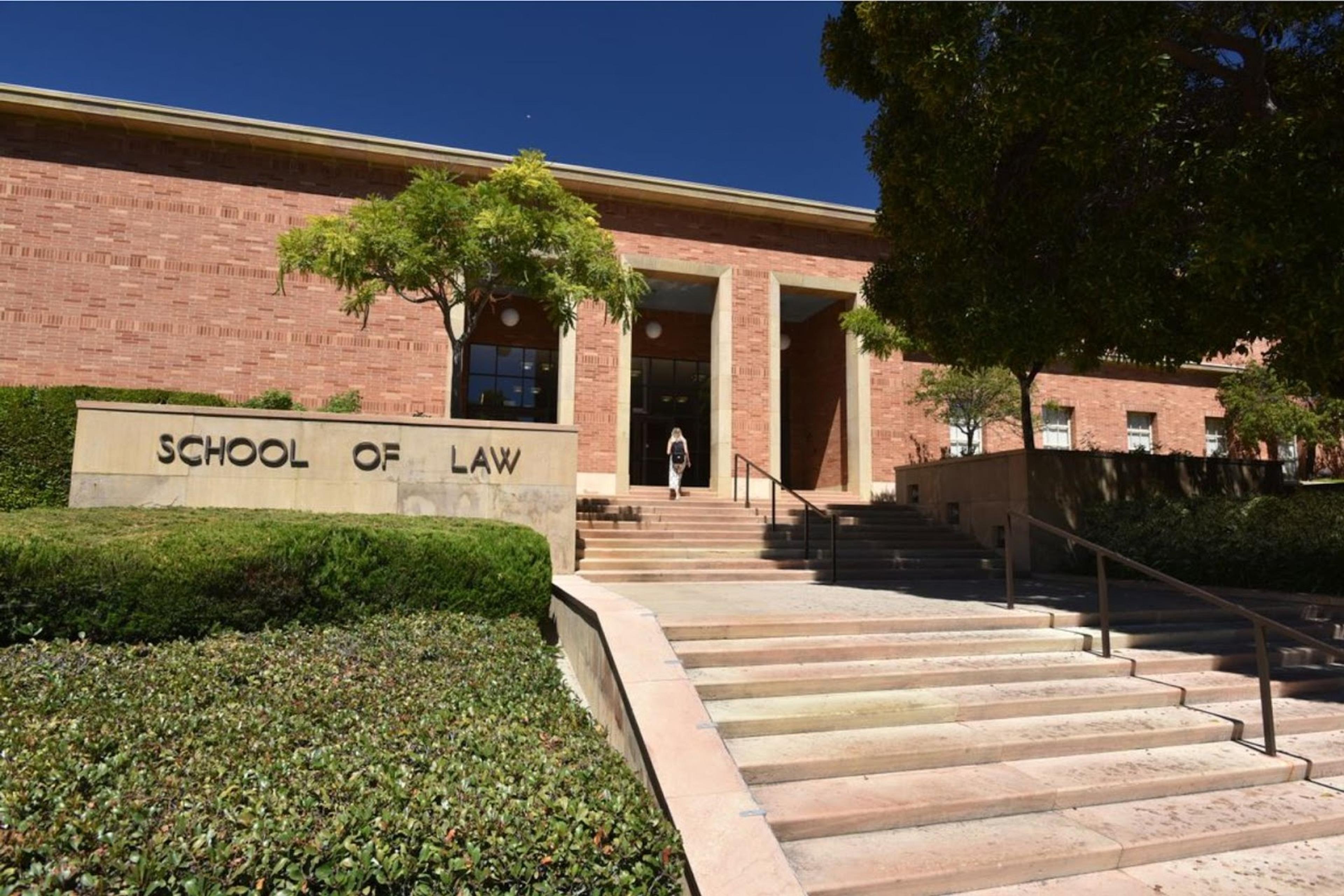Stanford Law Personal Statement Guide: Examples & Admit Tips
Learn how to craft a standout personal statement for Stanford Law School with our expert tips and guidance.
Posted August 25, 2025

Table of Contents
Free Event

Featuring Indrani S.
How To Write Outstanding Law School Application Essays
Starting Tuesday, September 2
11:30 PM UTC · 60 minutes

Featuring Indrani S.
Crafting a Stanford Law personal statement is one of the most important steps in the law school application process. For law school applicants, the essay is not simply a writing exercise, but it’s your chance to stand out to the admissions committee at one of the most selective schools in the world. A strong personal statement can be the difference between being waitlisted and being offered admission.
This guide breaks down everything you need to know: Stanford’s official requirements, examples of what works, strategies from admitted students, and the strategic advantage of optional short essays.
Read: How to Write a Powerful Personal Statement for Your Law School Applications
Why the Personal Statement Matters
The personal statement is central to law school admissions because it goes beyond numbers. A high LSAT score and academic achievements may show intellectual ability, but essays reveal character, values, and career goals.
At Stanford Law School, the admissions committee members specifically look for applicants who will make a distinctive contribution to the law school community. They want to see:
- Life experiences that shaped your perspective.
- Personal experiences that show resilience, authenticity, or a commitment to public service.
- Past experiences that highlight growth and readiness to study law.
- A clear connection to the school's educational mission.
As one current student shared, “Stanford is looking for people who are different, not just smart. Your essay has to show how you think and how you’ll contribute to the student body.”
Stanford Law Personal Statement Requirements
According to Stanford’s official JD Application Process:
- The personal statement should be approximately two pages, double-spaced, using a professional format (think 11–12pt font, one-inch margins).
- There is no strict page limit, but brevity and focus matter.
- The essay should explain how your educational background, personal history, and career history inform your decision to pursue law.
- The application fee is $100, and like other law schools, Stanford operates under rolling admissions, meaning earlier is better.
Stanford also allows optional short essays where applicants can expand on diversity, sexual orientation, gender identity, military service, or community service. These are not mandatory, but they provide a strategic advantage by allowing you to share more depth than in your law school personal statement alone.
How to Structure Your Stanford Law Personal Statement
A truly compelling law school personal statement for Stanford follows a deliberate structure: it tells a cohesive story while proving you have the intellect, drive, and values to thrive in one of the world’s most competitive programs. Think of it as a three-act narrative where every section builds credibility and momentum.
1. Introduction – Hook the Reader’s Attention Immediately
Your opening paragraph is the first thing the admissions committee will encounter, which means it needs to capture attention from the start. The strongest introductions begin with a personal anecdote or a key moment that shaped your decision to attend law school. This is not the place for a generic statement like “I’ve always wanted to be a lawyer.” Instead, transport the reader into a vivid scene or a turning point that illustrates your motivation with authenticity. Perhaps it was an experience in community advocacy, an encounter with the legal system, or a moment of personal growth that changed the way you saw the world.
The goal is to show, not tell. Rather than declaring that you care about justice, describe the experience that made you care. Weaving in how this moment influenced your development and commitment to a legal career will give your essay both energy and substance. Keep your first paragraph concise — ideally five to seven lines that establish your voice and direction while leaving the reader curious to learn more.
Example:
“At a nonprofit law clinic, I watched clients silenced by a system they couldn’t navigate alone. Seeing how the law could both empower and exclude was the moment I knew I needed to dedicate my life to public interest law.”
This type of opening not only draws the reader in but also signals that the essay will be substantive and mission-driven, exactly what Stanford values.
2. Body – Demonstrate Fit and Particular Skills
The body of your essay is where you prove that you are not just passionate but also prepared. Every paragraph should reinforce two ideas: first, that you have already shown evidence of excellence, and second, that your trajectory naturally points toward Stanford Law School.
One way to do this is by connecting your academic achievements and academic work to Stanford’s rigor. If you have demonstrated academic excellence in research, writing, or advocacy, provide concrete examples that show you are ready for advanced legal studies. Beyond academics, highlight particular skills such as resilience, leadership, or collaboration that you have cultivated in internships, community projects, or other meaningful experiences. Admissions readers are not just looking for intellectual capacity; they want future lawyers who can lead, problem-solve, and thrive in a collaborative law program.
The strongest essays also bring the reader into your story through vivid detail. Did you face a challenge that demanded grit? Did you influence change through community service or advocacy? Be specific about the personal experiences that shaped your perspective and prepared you for law school. Finally, demonstrate that you understand Stanford itself. Reference Stanford Law School programs such as international legal studies or its renowned clinics, and show how these opportunities align with your career goals. This signals genuine enthusiasm and a well-researched commitment.
As one admitted student shared on Reddit: “What got me in wasn’t listing all my jobs. It was writing an essay that showed I understood what makes Stanford unique — collaboration, creativity, and using the law as a tool for impact.”
3. Conclusion – Deliver a Forward-Looking Vision
Your conclusion should do more than summarize what you’ve already written. It is your chance to leave the admissions committee with a clear and memorable impression of your purpose, values, and potential impact. This is where you tie your past preparation to your future ambitions, and make the case that Stanford is the bridge between the two.
Reinforce how your background, career goals, and dedication to public service align with Stanford’s mission. Then, project forward. Describe how you envision contributing to the student body and future law students, not only as a learner but as a leader and collaborator. Admissions officers should come away convinced that your path at Stanford will amplify both your abilities and the community around you.
End with confidence and conviction. Show that you are not only ready to apply to law school but also to thrive in it, and ultimately begin practicing law in the service of a greater purpose.
Example closing move:
“My journey from community advocacy to advanced research has been fueled by the belief that the law must serve those most often overlooked. At Stanford, I will refine that mission, contribute to a collaborative law school community, and carry forward the school’s tradition of leadership in public service.”
This type of ending brings your essay full circle. It connects the moment that sparked your interest, the skills and preparation you have built along the way, and the vision of how you will use your training to make a difference. It also signals to the admissions committee that you are ready to excel at Stanford and use your legal education to create a lasting impact.
Personal Statement Format for Stanford Law
A Stanford Law personal statement is not just any essay, it is a professional narrative that must strike a balance between storytelling and strategy. While there is flexibility in how you structure your writing, the most successful law school personal statements follow a clear, deliberate format that allows the admissions committee to quickly grasp your motivations, strengths, and fit with the law school community.
Length and Technical Guidelines
Stanford recommends keeping the essay to approximately two pages, double-spaced, in a professional font such as Times New Roman or Arial at 11–12 point size. Margins should be one inch. This ensures readability and conveys professionalism. While there is no strict page limit, clarity and conciseness are valued. Admissions officers review thousands of essays each year: a tightly written two-page narrative signals discipline and respect for their time.
Recommended Structure
| Section | Purpose | What to Include | Expert Tip |
|---|---|---|---|
| 1. Introduction (Hook & Theme) | Capture the reader’s attention and set the essay’s tone. | Begin with a personal anecdote or key moment that sparked your decision to attend law school. Establish both your theme and context in 2–3 sentences. | Avoid clichés like “I’ve always wanted to be a lawyer.” Anchor your story in a lived experience that shaped your motivation. |
| 2. Body (Evidence & Fit) | Provide depth and demonstrate why you’re prepared for Stanford. | Show evidence of preparation: Connect academic achievements, life experiences, or personal history to skills needed in legal education. Highlight particular skills: Emphasize resilience, leadership, collaboration, intellectual curiosity. Demonstrate alignment: Reference Stanford Law School programs (clinics, international legal studies, public interest law) to prove intentional fit with the specific school. | Use vivid examples rather than abstract claims. Every paragraph should tie your story back to qualities Stanford values. |
| 3. Conclusion (Future Vision & Contribution) | Leave the admissions committee with a strong, forward-looking impression. | Show how your background and personal experiences inform your career goals. Explain how attending law school aligns with your long-term vision of service and leadership. | End with confidence. Signal that you’re ready to apply to law school, thrive at Stanford, and contribute to the legal profession. |
Read: Law School Personal Statement Format & Length: Guide & Tips
Chronological vs. Thematic Organization
Many applicants find it easiest to write their personal statement in a chronological format: starting with a formative event, moving through relevant past experiences, and ending with current goals and future vision. This approach creates a natural flow and helps the reader track your development.
However, a thematic format can be equally powerful. In this approach, you organize around a central theme — for example, resilience, advocacy, or innovation — and weave in stories from different parts of your life that illustrate that theme. Thematic essays work especially well for applicants with diverse career histories or non-linear paths.
Both structures are acceptable, but whichever you choose must read as intentional, polished, and cohesive.
Pro tip from experts: Admissions readers don’t expect literary brilliance, but they do expect clarity, authenticity, and professionalism. Each paragraph should serve a purpose: to show who you are, why you’re prepared, and how you’ll contribute. As one Stanford student explained, “The essays that stood out weren’t the flashiest, but they were the ones that made me feel like I knew the person and could picture them thriving here.”
Stanford Law Personal Statement Examples
The best Stanford Law personal statements are not just stories; they are carefully crafted narratives that reveal character, motivation, and alignment with Stanford’s mission. Below are three examples drawn from real-world themes, insights, and best practices, along with commentary on why they resonate with the admissions committee.
Example No. 1 — From Family Hardship to Legal Curiosity
"At sixteen, I often found myself at the kitchen table with my father, staring at legal documents that neither of us fully understood. My parents’ small business was in the middle of a lawsuit, and the language that confused my family strangely fascinated me. I began looking up terms, decoding clauses, and piecing together arguments. What started as a way to ease my father’s stress became my first step into the world of law. By the time I shadowed our attorney, I already knew I had found not just a career path, but a calling. I realized that the law was not just abstract rules; it was power, protection, and responsibility — and I wanted to learn how to wield it responsibly."
Why it works: This essay transforms a personal family crisis into an intellectual awakening. It shows resilience, curiosity, and initiative — qualities Stanford values. The applicant doesn’t just describe hardship; they demonstrate how it sparked a passion for law and a trajectory toward a legal career.
Example No. 2 — Mock Trial and the Power of Preparation
"The cafetorium hardly resembled a courtroom, but as I walked to the podium for my closing arguments, I felt the weight of advocacy. I had spent weeks preparing for this mock trial, mentored by a local attorney who grilled me until I knew the case backward and forward. My hands still trembled as I spoke, but my voice carried. When the jury announced a guilty verdict, my mentor leaned over and whispered, ‘This feeling never goes away. You’re made for this.’ It was in that moment that I realized I loved not just the performance of law, but the foundation beneath it — the meticulous preparation, the crafting of arguments, and the pursuit of truth."
Why it works: This essay highlights discipline and preparation, not just theatrics. It illustrates particular skills Stanford seeks — intellectual rigor, resilience, and the ability to thrive under pressure. The mentor’s validation underscores the applicant’s potential, while the narrative reveals both skill and humility.
Example No. 3 — Leading Through Adversity
"During my Victimology course, I was assigned to a group project with a teammate who was on the verge of dropping out. At first, I felt frustrated by her lack of engagement, especially as I juggled school, work, and my father’s recovery from surgery. But instead of letting her slip away, I invited her for coffee and asked what she needed. Together, we restructured the workload, and by the end of the semester, she had become one of our most committed contributors. That project taught me that leadership is not just about efficiency; it’s about empathy. The same persistence that pushed me through my own challenges gave me the patience to lift others. In law, I know I’ll face adversaries across the table, but also colleagues and clients who need understanding as much as strategy."
Why it works: This essay demonstrates maturity and empathy — qualities often undervalued but deeply respected by the admissions committee. By showing growth through teamwork and personal responsibility, the applicant highlights their readiness to contribute meaningfully to the law school community and to Stanford’s culture of collaboration.
Common Mistakes to Avoid in Personal Statements
Crafting a strong personal statement is critical for law school applications, and avoiding common errors can make a significant difference. Here are key mistakes to avoid and strategies to ensure your personal statement stands out.
- Failing to proofread for clarity and precision undermines the credibility of your application.
- Ignoring Stanford Law’s expectations weakens your ability to connect with the school’s mission.
- Using generic language or clichés makes your narrative less engaging and impactful.
- Failing to demonstrate a clear connection to Stanford Law reduces the statement’s relevance.
- Not following a logical structure confuses readers and detracts from your message.
- Overloading with information diminishes focus and weakens the clarity of your story.
- Failing to show rather than tell makes your examples less compelling and vivid.
- Neglecting authenticity makes your statement feel impersonal and disconnected.
- Omitting relevant keywords can reduce the alignment of your statement with expectations.
Making the Statement Memorable
Admissions committees value applicants who can communicate effectively and present a unique perspective. Incorporating terms like “strong essays,” “well-written,” and “academic work” shows attention to detail and professionalism. Highlighting diversity, such as contributions to public interest law or experiences with the school's educational mission, further enriches the narrative.
Using a compelling structure, emphasizing authenticity, and tailoring content to Stanford’s values significantly enhance the chances of being offered admission.
The Bottom Line
Crafting a standout personal statement for Stanford Law School is an essential step in the application process. Your personal statement should reflect your unique experiences, academic achievements, and how your aspirations align with Stanford's values, particularly in public service and innovation. It’s not just about showcasing your qualifications but demonstrating your fit for the school’s community. By thoughtfully addressing your motivations for pursuing law, sharing personal stories, and highlighting how you can contribute to the Stanford Law community, you’ll make a compelling case for your admission.
How Top Law School Admissions Consultants Can Help
Securing admission to a top-tier institution like Stanford Law School requires a strategic and polished approach to crafting your personal statement. Working with experienced law school admissions coaches can make a significant difference in this process. These experts provide tailored guidance on structuring your narrative, highlighting specific examples, and aligning your story with Stanford’s educational mission.
They can also help you leverage optional essays to strengthen your application further. By collaborating with knowledgeable professionals, applicants can maximize their chances of presenting a compelling case for admission to one of the most prestigious law schools in the world.
Also, check out our law school application bootcamp and free events and group classes to unlock your full law school potential!
See: The 10 Best Law School Coaches | Law School Admissions Consulting That Works
Read next:
- Harvard Law Personal Statement Guide: Examples & Admit Tips
- Northwestern Law Personal Statement — Overview & Analysis
- T14 Law Schools: Acceptance Rates & Class Profiles
- How to Get Into Law School: Advice From an Expert
- Law School Application Deadlines (T20 Programs)
- NYU Law Personal Statement Guide: Examples & Admit Tips
- LSAC Credential Assembly Service (CAS): What it Is and How It Works for Law School Applications
- How Many Letters of Recommendation for Law School: A Comprehensive
FAQs
Is there a specific format or font requirement for the personal statement?
- Stanford Law School does not mandate a specific format or font for the personal statement. However, it is advisable to use a standard, professional font such as Times New Roman or Arial, in 11 or 12-point size, with double-spacing and one-inch margins to ensure readability.
Can I submit an addendum alongside my personal statement?
- Yes, applicants may submit an addendum to address any aspects of their application that may require further explanation, such as discrepancies in academic records or gaps in employment. This should be concise and directly relevant to the information needing clarification.
Read: Law School Addendum: Writing Tips and Samples
How does the personal statement differ from the optional essays?
- The personal statement is a required component where applicants discuss their life experiences, interests, and character, highlighting how they can contribute to Stanford Law School. Optional essays, on the other hand, provide an opportunity to elaborate on specific topics, such as encountering contrasting viewpoints, allowing applicants to showcase additional dimensions of their experiences and perspectives.
Should I address my interest in specific Stanford Law programs within my personal statement?
- While not mandatory, discussing particular programs or aspects of Stanford Law that align with your interests can demonstrate a well-researched and genuine enthusiasm for the school. This can help illustrate how you plan to engage with the community and resources available at Stanford.
Is it acceptable to mention personal experiences with the legal system in my personal statement?
- Yes, sharing personal experiences with the legal system can be impactful, especially if these experiences have influenced your decision to pursue a legal career. Ensure that such narratives are presented thoughtfully and reflectively, focusing on how they have shaped your perspectives and aspirations.
Can creative writing elements be incorporated into the personal statement?
- While the personal statement should maintain a professional tone, incorporating creative writing elements, such as storytelling or vivid descriptions, can make your narrative more engaging. The key is to balance creativity with clarity, ensuring that your message remains coherent and effectively communicates your qualifications and motivations.











